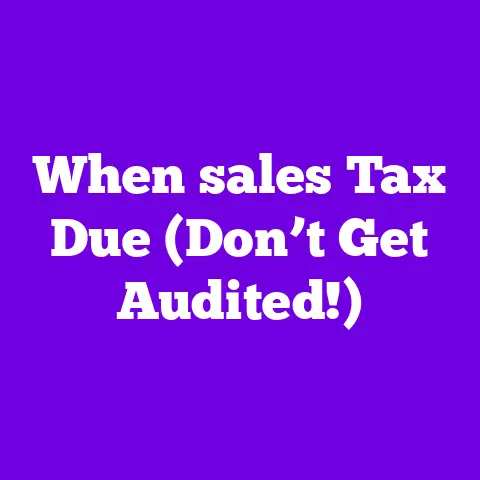Is sales Tax Refunded Online? (Don’t Miss Out!)
As we move deeper into 2025, the world is increasingly aware of the importance of financial prudence and sustainability.
Every dollar saved is a step towards a more secure future, and understanding how to reclaim what’s rightfully yours is more critical than ever.
Sales tax, a seemingly small percentage at the point of purchase, can add up significantly over time.
Are you aware that you might be entitled to a refund on sales tax paid online?
I’m here to guide you through the ins and outs of online sales tax refunds in 2025, ensuring you don’t miss out on potential savings.
Understanding Sales Tax
Sales tax is a consumption tax imposed by many state and local governments on the sale of goods and services.
It’s a primary revenue source that funds essential public services like education, infrastructure, and public safety.
As of 2023, 45 states and the District of Columbia impose statewide sales taxes (source: Tax Foundation).
The rates vary significantly.
For example, California has a base sales tax rate of 7.25%, but when local taxes are added, it can exceed 10% in some areas.
On the other hand, states like Oregon, Delaware, Montana, New Hampshire, and Alaska have no statewide sales tax.
The rise of e-commerce has complicated sales tax collection.
Before the South Dakota v.
Wayfair, Inc. Supreme Court decision in 2018, states could only require businesses with a physical presence (nexus) in their state to collect sales tax.
Wayfair changed that, allowing states to require out-of-state retailers to collect sales tax if they meet certain economic thresholds (source: Avalara).
This means online purchases are now almost universally subject to sales tax, impacting consumers nationwide.
Sales tax refunds arise in several scenarios:
- Returned Items: If you return an item you purchased online, you’re generally entitled to a refund of the sales tax you paid.
- Incorrect Charges: Sometimes, errors occur, and you may be overcharged sales tax.
- Tax-Exempt Purchases: Certain organizations (e.g., non-profits, government entities) are exempt from sales tax and can claim refunds on eligible purchases.
The Online Sales Tax Refund Process
Seeking a sales tax refund online involves a few key steps.
While the specific process can vary by retailer and state, here’s a general outline:
- Identify the Reason for the Refund: Determine why you believe you’re entitled to a refund.
Was it a returned item, an overcharge, or a tax-exempt purchase? - Gather Documentation: Collect all relevant documentation, including:
- Proof of Purchase: The original receipt or order confirmation.
- Return Confirmation (if applicable): Documentation confirming the item was returned and accepted.
- Tax-Exempt Certificate (if applicable): Your organization’s tax-exempt certificate.
- Contact the Retailer: Initiate the refund request with the online retailer.
Most retailers have a dedicated customer service channel for handling returns and refunds. - File a Claim (if necessary): If the retailer denies the refund or fails to respond, you may need to file a claim directly with the state’s tax agency.
This is more common for large discrepancies or tax-exempt purchases.
Common Scenarios for Refunds:
Typical Timelines and Fees:
- Retailer Refunds: Retailers typically process refunds within 7-14 business days after receiving the returned item or approving the refund request.
- State Refunds: If you need to file a claim with the state, the processing time can vary significantly, ranging from a few weeks to several months.
- Fees: Generally, retailers do not charge fees for processing sales tax refunds on returned items or incorrect charges.
However, some states may charge a small processing fee for filing a claim directly with the tax agency.
Technological Advances in Tax Refunds
Technology is revolutionizing the sales tax refund process, making it more efficient and accessible.
Online Platforms and Apps: Several platforms and apps are designed to help consumers identify and claim eligible refunds.
These tools often automate the process of tracking purchases, identifying potential errors, and filing refund requests.
Some examples include:
- TaxJar: While primarily focused on businesses, TaxJar offers resources and tools that can help consumers understand sales tax obligations and identify potential refund opportunities (source: TaxJar).
- Refund Retriever: This service focuses on identifying shipping errors and late deliveries, which can sometimes result in sales tax refunds (source: Refund Retriever).
Artificial Intelligence (AI) and Machine Learning (ML): AI and ML are playing an increasingly important role in identifying eligible refunds and streamlining the process.
These technologies can analyze purchase data, identify patterns of overcharging, and automate the filing of refund requests.
E-commerce Trends: The rise of subscription services and digital goods presents new challenges and opportunities for sales tax refunds.
States are still grappling with how to apply sales tax to these evolving business models, which can lead to confusion and potential overcharges.
State-Specific Regulations and Variances
Sales tax regulations and refund processes vary significantly from state to state.
Here are a few examples:
- California: California allows consumers to claim refunds for sales tax paid on returned items directly from the retailer.
If the retailer denies the refund, consumers can file a claim with the California Department of Tax and Fee Administration (CDTFA). - Texas: Texas has a streamlined process for tax-exempt organizations to claim refunds on eligible purchases.
The Texas Comptroller’s office provides detailed guidance and online tools for filing refund requests. - New York: New York allows consumers to claim refunds for sales tax paid on returned items within 90 days of the purchase date.
Case Studies:
- California: A consumer in California purchased a laptop online and paid sales tax.
After discovering the laptop had a defect, they returned it to the retailer.
The retailer initially refused to refund the sales tax, claiming it was non-refundable.
However, after the consumer cited California’s sales tax regulations, the retailer relented and issued a full refund, including the sales tax. - Texas: A non-profit organization in Texas purchased office supplies online without providing their tax-exempt certificate at the time of sale.
The organization subsequently filed a refund request with the Texas Comptroller’s office, providing the necessary documentation.
The Comptroller’s office approved the refund, and the organization received a check for the sales tax paid.
Upcoming Changes in Legislation:
Several states are considering changes to their sales tax laws that could impact online sales tax refunds in 2025.
Stay informed about these changes by monitoring your state’s tax agency website and consulting with a tax professional.
Common Myths and Misconceptions
Several myths and misconceptions surround online sales tax refunds. Let’s debunk a few:
- Myth: “Sales tax is never refundable.”
- Fact: Sales tax is often refundable in specific circumstances, such as returned items, incorrect charges, or tax-exempt purchases.
- Myth: “It’s too difficult to claim a sales tax refund.”
- Fact: While the process can be complex, especially when dealing directly with the state, many retailers offer streamlined refund processes for returned items.
- Myth: “Claiming a sales tax refund will increase sales tax rates.”
- Fact: Individual refund claims do not directly impact sales tax rates.
Sales tax rates are determined by state and local governments based on budgetary needs.
- Fact: Individual refund claims do not directly impact sales tax rates.
FAQs:
- Q: How long do I have to claim a sales tax refund on a returned item?
- A: The timeframe varies by state and retailer.
Generally, you should initiate the refund request as soon as possible after returning the item.
- A: The timeframe varies by state and retailer.
- Q: What if the retailer refuses to refund the sales tax?
- A: If the retailer refuses to refund the sales tax, you can file a claim directly with your state’s tax agency.
- Q: Can I claim a sales tax refund on a digital good, like an e-book?
- A: It depends on the state.
Some states tax digital goods, while others do not.
If you were incorrectly charged sales tax on a digital good, you may be able to claim a refund.
- A: It depends on the state.
The Financial Impact of Sales Tax Refunds
Sales tax refunds can have a significant impact on consumers’ financial well-being.
Every dollar refunded is a dollar that can be used for other essential expenses, investments, or savings.
Budgeting and Financial Planning:
Sales tax refunds can be incorporated into your budgeting and financial planning.
By tracking your purchases and identifying potential refund opportunities, you can create a more accurate budget and allocate your resources more effectively.
Consumer Spending and Sustainable Practices:
The ability to reclaim sales tax on returned items encourages more responsible consumer spending.
By knowing that you can get a refund if an item doesn’t meet your needs, you may be more willing to try new products or support sustainable businesses.
Conclusion
Understanding the ins and outs of online sales tax refunds in 2025 is crucial for maximizing your financial well-being.
While the process can be complex, especially given the variations across states, the potential savings are well worth the effort.
I encourage you to take proactive steps in seeking refunds on eligible purchases.
Don’t miss out on the opportunity to reclaim what’s rightfully yours.
Staying informed about the latest sales tax regulations and leveraging technological tools can help you navigate the process and ensure you receive the refunds you deserve.
Remember, every dollar saved contributes to a more secure financial future and supports responsible consumer practices.






